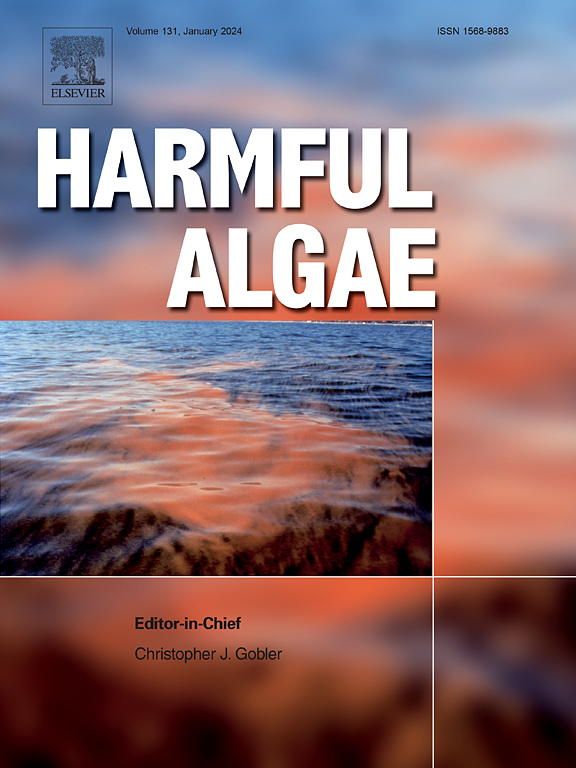Copper sulfate treatment harms zooplankton and ultimately promotes algal blooms: A field mesocosm experiment
IF 5.5
1区 生物学
Q1 MARINE & FRESHWATER BIOLOGY
引用次数: 0
Abstract
Excess nutrient loading often promotes harmful algal blooms. Despite many past studies, few algal bloom control methods show clear, long-term improvements in water quality. For example, chemical treatments are often used to control algal blooms because they can cause large, rapid declines in algal abundance. However, these effects are often transient requiring future treatments that increase costs and risks to water quality. Moreover, empirical tests of repeated applications or combinations of different treatments are rare, even with their common use across industries, like aquaculture and drinking water. To rigorously test the effects of single or combined treatments on water quality in a eutrophic aquaculture pond, copper sulfate pentahydrate (henceforth called copper) and Phoslock were used independently (full dose) or combined (each at half dose) in a 56-day field experiment conducted in a hypereutrophic aquaculture pond. The two copper-containing treatments caused rapid declines (-83%) in algal abundance the day after treatment followed by very large (2,617%) increases after another five days. In contrast, zooplankton were reduced by 43% in the copper treatment but minimally affected (+1%) by the combined treatment the day after application. To further show that copper treatment is the mechanism responsible for the negative effects on zooplankton and phytoplankton, half of the mesocosms for all four treatments were treated with a full dose of copper on day 13 and similar effects on phytoplankton were observed as when copper was initially applied. The combined treatment was more effective at controlling phytoplankton than the copper only treatment, in part, because of lesser negative effects on zooplankton. Overall, this experiment further highlights the long-term, negative effects that chemical treatments, like copper, have on non-target taxa, such as beneficial zooplankton, which limits their potential for ecological and sustainable control of harmful algal blooms.

硫酸铜处理危害浮游动物并最终促进藻华:一项野外中生态实验
过量的营养负荷往往会促进有害的藻类繁殖。尽管过去有许多研究,但很少有控制藻华的方法显示水质有明显的、长期的改善。例如,化学处理通常用于控制藻华,因为它们会导致藻类丰度大幅迅速下降。然而,这些影响往往是暂时的,需要未来的处理,这增加了成本和对水质的风险。此外,即使在水产养殖和饮用水等行业中普遍使用,对不同处理方法的重复应用或组合进行的实证测试也很少见。为了严格测试单一或联合处理对富营养化养殖池塘水质的影响,在一个富营养化养殖池塘进行了为期56天的实地试验,分别使用五水硫酸铜(以下简称铜)和Phoslock(全剂量)或联合使用(各半剂量)。两种含铜处理在处理后第一天藻类丰度迅速下降(-83%),5天后藻类丰度大幅增加(2617%)。相比之下,铜处理的浮游动物减少了43%,但在施用后的第一天,联合处理的影响最小(+1%)。为了进一步证明铜处理是对浮游动物和浮游植物产生负面影响的机制,在第13天,所有四种处理中一半的中胚层都接受了全剂量的铜处理,观察到对浮游植物的影响与最初施用铜时相似。联合处理在控制浮游植物方面比单独的铜处理更有效,部分原因是对浮游动物的负面影响较小。总的来说,该实验进一步强调了化学处理(如铜)对非目标分类群(如有益的浮游动物)的长期负面影响,这限制了它们对有害藻华的生态和可持续控制的潜力。
本文章由计算机程序翻译,如有差异,请以英文原文为准。
求助全文
约1分钟内获得全文
求助全文
来源期刊

Harmful Algae
生物-海洋与淡水生物学
CiteScore
12.50
自引率
15.20%
发文量
122
审稿时长
7.5 months
期刊介绍:
This journal provides a forum to promote knowledge of harmful microalgae and macroalgae, including cyanobacteria, as well as monitoring, management and control of these organisms.
 求助内容:
求助内容: 应助结果提醒方式:
应助结果提醒方式:


